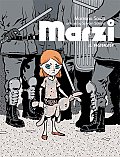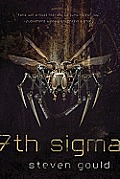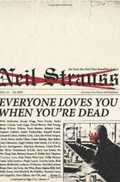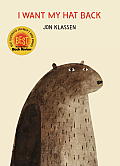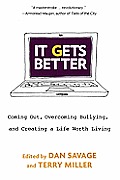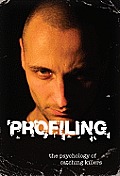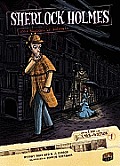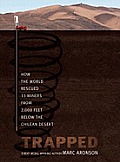Link to this review in the form of a comic strip by geneambaum tagged history • biography • graphic novel
Link to this review by billba tagged science fiction
Fifty years ago the Earth was invaded by metal-eating bugs. It was bad, but it could have been worse. The bugs are allergic to water, and so mostly confine themselves to the American Southwest. A variety of idiosyncratic freedom-lovers has settled there and established a low-tech culture. Among them is Kim, a young man seeking to avoid being reunited with his abusive father.
Why I picked it up: It’s a great premise. And I loved Gould’s Jumper and Wildside, two solid YA science fiction novels.
Why I finished it: For someone who enjoys gadgets as much as I do, I think the amount of technology in our lives is overwhelming. This very cleverly imagined world made me yearn for a simpler time. And a drier climate.
I’d give it to: Jeff, my best man, who studies Aikido like Kim. He will appreciate that Gould focuses on Kim’s increasing spirituality and maturity over the simple martial art mechanics of throws (though there are some of those, too).
Link to this review by geneambaum tagged nonfiction • essays
Neil Strauss has written thousands of newpaper and magazine articles on celebrities and bands (plus a few bestselling books). These are transcripts of the best moments from the original interviews. Most of the interviews were with music and media-related celebrities. There are a few “normal” folks here, too, like a groupie and Russell Targ, who developed psychic spies for the CIA. The moments range from rude to confessional, confused (or confusing) to insightful, and educational to just plain crazy.
Why I picked it up: There’s a list of celebrities on the cover, and I know 99% of them. Plus I’ve done a few interviews in the last year, and I wanted to see if i could pick up any tips about how to do them better.
Why I finished it: The interview snippets are short, so even if I disliked the interviewee, I read the interview because it was over in a moment. Strauss makes a run to the store with Snoop Dog to buy diapers. He introduces the second part of the interview with Kenny G with “…if everybody were as gentle, pleasant, and meek as Kenny G the world would be a much better place. Though the radio would suck.” Judd Apatow explains why directing a sex scene between his wife and real-life best friend in Funny People made him laugh. Eric Clapton talks about getting clean after his son’s accidental death. Members of Soul Asylum wonder what could possibly be interesting about them. Marilyn Manson discusses his collection of prosthetic limbs and the fan who wanted to give him the leg the fan was wearing.
I’d give it to: My friend Dean, an avid Rolling Stone reader and rock fan, who would devour the interviews with Slipknot percussionist Shawn Crahan (which show he’s a normal guy, though it’s hard to tell through the clown costume) and Mötley Crüe’s answers to a lawyer’s fact checking email, prior to the release of The Dirt, which seem to prove everything you might have heard about them is true. (Dean would complain that Strauss didn’t interview members of GWAR, but no book is perfect.) And my friend Marin, who hates writing dialogue, because this is a completely entertaining guide to how to capture spoken mannerisms in print.
Link to this review by gigi tagged picture book
Bear lost his hat. He asks a turtle, a frog, a fox, and other animals if they’ve seen it. But then he realizes he has seen his hat.
Why I picked it up: I liked the picture of the bear on the cover because the bear is big and not scary.
Why I finished it: I liked the part when the rabbit talks more than everyone else and keeps saying that he hasn’t seen it and wouldn’t steal a hat.
I’d give it to: I would give it to Lily because she would like the part when the slow turtle says, “I haven’t seen anything all day. I have been trying to climb this rock.”
Link to this review by sharonlevin tagged nonfiction • essays • coming of age
Many LGBT youth commit or attempt suicide because of bullying. Dan Savage (Savage Love, The Kid, The Commitment) was deeply disturbed by the suicides of fifteen-year-olds Justin Aaberg and Billy Lucas. Both were bullied for being gay or perceived as gay. Savage wrote a blog post about Billy. A reader left this comment: “My heart breaks for the pain and torment you went through, Billy Lucas. I wish I could have told you that things would get better.”
Realizing that this is a simple powerful truth, he wanted a way to deliver this message to LGBT teens. Savage and his husband, Terry Miller, created the first It Gets Better video, letting LGBT teens know that life does get better. Almost instantly, others started posting their own videos. The It Gets Better Project “has turned into a worldwide movement, inspiring more than 30,000 user-created videos viewed more than 40 million times.”
This book contains essays both from the video project and others written specifically for it. They range from people talking about how difficult high school was to others reminding the LGBT community that there are many who support them.
Why I picked it up: I live in a liberal bubble and people around me (in the San Francisco Bay area) are not homophobic. But then a friend of a friend of my daughter was transitioning in high school, and ended up committing suicide because of bullying. It made me rethink my complacency and my belief that it’s now safe and accepted to be openly lesbian, gay, bisexual, or transgender.
Why I finished it: The stories are similar, but everyone’s experience is completely different. One of the most heartbreaking yet uplifting stories was written by Randy Roberts Potts, the grandson of evangelist Oral Roberts. It’s a letter to his Uncle Ronnie, who was gay. He faced so much hatred and shame from his own family that, six months after coming out, he shot himself. Randy is also gay and also has a parent who does not want a gay son. After a long hard road (including a bitter ex-wife who continued calling him “faggot” in front of the kids until he took her to court) he is now a happy, confident man – and very glad that he hung in there, until his life got better.
I’d give it to: Me, in high school. I was quite naive. At a party once a boy I knew went into a bedroom and came out wearing a dress, high heels and makeup. He broke down, saying, “You guys, I’m not gay, I’m not gay.” While not all transvestites are gay, Mike was, and dealing with that caused him a great deal of pain in our small, conservative town. I wish I knew then what I know now (the refrain of so many people my age) and told him it was okay.
Link to this review by sarahhunt tagged picture book • classic • graphic novel • anthology
Comics artists, both acclaimed and up-and-coming, create delightful full-color comics versions of nursery rhymes.
Here’s a list of contributing cartoonists: Nick Abadzis, Andrew Arnold, Kate Beaton, Vera Brosgol, Nick Bruel, Scott Campbell, Lilli Carre, Roz Chast, JP Coovert, Jordan Crane, Rebecca Dart, Eleanor Davis, Vanessa Davis, Theo Ellsworth, Matt Forsythe, Jules Feiffer, Bob Flynn, Alexis Frederick-Frost, Ben Hatke, Gilbert Hernandez, Jaime Hernandez, Lucy Knisley, David Macaulay, Mark Martin, Patrick McDonnell, Mike Mignola, Tony Millionaire, Tao Nyeu, George O’Connor, Mo Oh, Eric Orchard, Laura Park, Cyril Pedrosa, Lark Pien, Aaron Renier, Dave Roman, Marc Rosenthal, Stan Sakai, Richard Sala, Mark Siegel, James Sturm, Raina Telgemeier, Craig Thompson, Richard Thompson, Sara Varon, Jen Wang, Drew Weing, Gahan Wilson, Gene Luen Yang, Stephanie Yue.
Why I picked it up: I first saw it mentioned in Richard Thompson’s blog (he does a two-page version of “There Was an Old Woman Tossed Up in a Basket”), then I saw it mentioned by many, many more of my favorite comics artists.
Why I finished it: The book contains the best sort of illustration for reading aloud to little kids. The best contain lots of funny details and sometimes a whole other story for them to enjoy while you read. In Kate Beaton’s “The Grand Old Duke of York” (you can see the comic at the bottom of this page), the Duke’s men eat sandwiches and play cards after they’ve been marched up and down the hill. And Jack has clearly sacrificed the seat of a nice pair of pants at the end of James Sturm’s “Jack Be Nimble.”
This is the sort of book that I encourage parents to use to get their kids interacting with books, telling stories, and predicting what will happen next, the first steps to literacy and discovering the fun of reading.
I’d give it to: Milo (who’s just started chapter books) and his sister Delia (who’s just getting the hang of sounding out words) to read together. There’s stuff for each of them to laugh at and enjoy for years to come. Artists I love now still talk about the artists they enjoyed in the picture books they grew up with, like Mary Blair and Syd Hoff, just like I still remember my favorites. The contributors to this collection will be perfect seeds for Milo and Delia’s future artistic literacy.
Link to this review by flemtastic tagged nonfiction • mystery
Through information from serial killers’ case files, this book explains profiling techniques that the FBI and police used to capture them. Agents classify serial killers into four classes: power-reassurance, power-assertive, anger-retaliatory, and anger-excitation/sadism. Based on behavioral profiles, experts recognize patterns, predict a killer’s next move, and put disparate murders together into one case.
Includes color photos, several of which are quite graphic. (I randomly opened it to a picture of a torso with its legs removed.)
Why I picked it up: What CSI fan could pass up a book about how modern police and the FBI catch serial killers through science?
Why I finished it: Sometimes, the profiles contained an incredible level of detail. One predicted a killer, when found, would be wearing a double-breasted suit. (He was apprehended wearing one.)
I’d give it to: John, who can’t understand murderers like Susan Smith, who drowned her kids by rolling her car into a lake while they were inside. The book addresses this need to get it, and ascribes motive when it can. (Smith had her eye on a man who she worried would look at her kids as baggage.)
Link to this review by geneambaum tagged graphic novel • mystery • historical fiction
Wilhelm Von Ormstein, King of Bohemia, needs to recover a photograph of himself and a well-known opera singer. She intends to ruin the King by sending the photo to his fiancee. Holmes and Watson set out to recover the photo.
Why I picked it up: My nine-year-old daughter loves Encyclopedia Brown and the BBC TV show Sherlock, and I was hoping for an adaptation that was accessible and entertaining.
Why I finished it: It’s both. Rohrbach’s drawings are large, simple, pleasant, and nicely colored, and many look like they might have been block printed. And the adaptation keeps a lot of the plot and tone of the original intact.
I’d give it to: My daughter, along with the next two books in the series. She’s really going to enjoy the way Holmes uses disguises and special effects to thwart the blackmailer.
Link to this review by flemtastic tagged nonfiction
In 2010, the world was transfixed by the story of the thirty-three Chilean miners trapped thousands of feet underground. Drilling rigs were sent from around the world, shipped (in one case by UPS) in giant airplanes. Mining experts came from Canada and Afghanistan. Once communication and a way to supply food had been set up (through a shaft the diameter of a grapefruit), a few men down below held the rest together, improving morale and giving them jobs to help cope while waiting for an escape shaft to be cut.
Includes maps, computer models, and pictures of the gear used.
Why I picked it up: I watched, in real time, as the first Chilean miner came out of the Phoenix capsule. I was holding my breath to see the condition of these men, and the first one looked healthy and happy. I wanted to know the whole story.
Why I finished it: Understanding just how tough it was for the drillers to hit the tiny part of the shaft where the survivors huddled made this improbable rescue even more thrilling.
I’d give it to: My sons’ friend Jacob, who took apart the family toaster when he was six, because he’d love the machinery and the problem solving that went in to saving these men.
